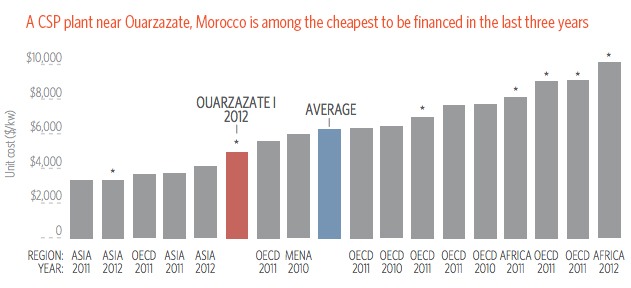Has Concentrated Solar Power (CSP) finally turned the corner, going from an emerging technology (albeit with 20 years of history) to an (almost) commercially-ready one?

CPI recently published an update to an earlier report on a large-scale CSP plant to be built near the city of Ouarzazate in Morocco. CPI finds that the project has apparently broken two taboos with the successful completion of its financing: the widely held view that a large scale infrastructure project could not be financed within its planned budget, even more so in an emerging economy; and that technology costs for CSP could not come down from the USD 6000/KW mark where they have been stuck since the ‘90s.
Indeed, for Ouarzazate I CSP, CPI estimates an overall unit-cost (including financing, contingencies and the expensive storage facility) of approximately USD 5,300/kW — more than 10% lower than initial projections. This means that the plant is among the cheapest ones to have been financed in the last three years. At the same time, the Moroccan Agency for Solar Energy (MASEN) has awarded the project a tariff 25% lower than what the Government of Morocco and the project proponents (all major multilateral development banks active in the region) had budgeted for.
It is however too early to call Ouarzazate I CSP a whopping success. While the early signs are promising, the plant must still be built and begin operating according to plan; and the project must also deliver the development and growth goals for the local community on which both the government and the development institutions have heavily betted.
These views emerged very clearly at the Solar Maghreb 2013 Conference held in Rabat in May this year, at which CPI was invited to present the study. Among the many ambitious wind, solar, and other renewable energy projects presented at the event, representatives from MASEN delivered an update on the proceedings for Ouarzazate I (now officially named Noor I) and for the incoming second, third, and fourth phases of the 500MW solar project. On one side the project’s advancements were very welcome news for the audience and a proof that the Agency is pushing ahead this ground-breaking investment. But on the other side, not everyone is convinced that the expensive CSP technology is the right choice for the development of the renewable sector in the country. Many are somewhat skeptical that the hefty financial commitment the government has embarked upon will be sustainable in the long run — the government has pledged to subsidize MASEN for the annual difference between the cost of CSP power and the national electricity price and has also issued sovereign guarantees to the lenders of the plant.
So in the whole region, the stakes in CSP are already high, and they are rising. Beyond the multi-billion Morocco solar program, Algeria is looking to close the financing of its first large-scale CSP plant by diverting some of its fossil fuel revenues into solar energy, Abu Dhabi has just announced the follow up project to its first CSP plant (the Shams 1). Beyond solar, the announced pipeline for wind project is already worth several billions. Additionally, these investments have drawn interest from the private arms of development institutions (IFC, KfW IPAX, EBRD were all present at the event) and some commercial banks. Attracting this private-sector investment is the first step, we believe, towards a true turning point for low-carbon investments in the region without over burdening public budgets.

